Welcome to the walkthrough of the Heart Failure: ACE Inhibitors & ARBs demo Nest (open in your original tab). In this walkthrough, we’ll explain the core functionalities of Nested Knowledge through this Nest. We encourage you to work through the Nest as you follow the walkthrough. The Nest available to you is a copy of the original and may be freely modified, so roll up your sleeves and get your hands dirty!
This Nest is a copy of a previously-completed review presenting a comparison of patient outcomes from treatment of Heart Failure with Angiotensin-converting enzyme (ACE) Inhibitors and Angiotensin II Receptor Blockers (ARBs) that were reported in randomized controlled trials (RCTs).
Nest Home #
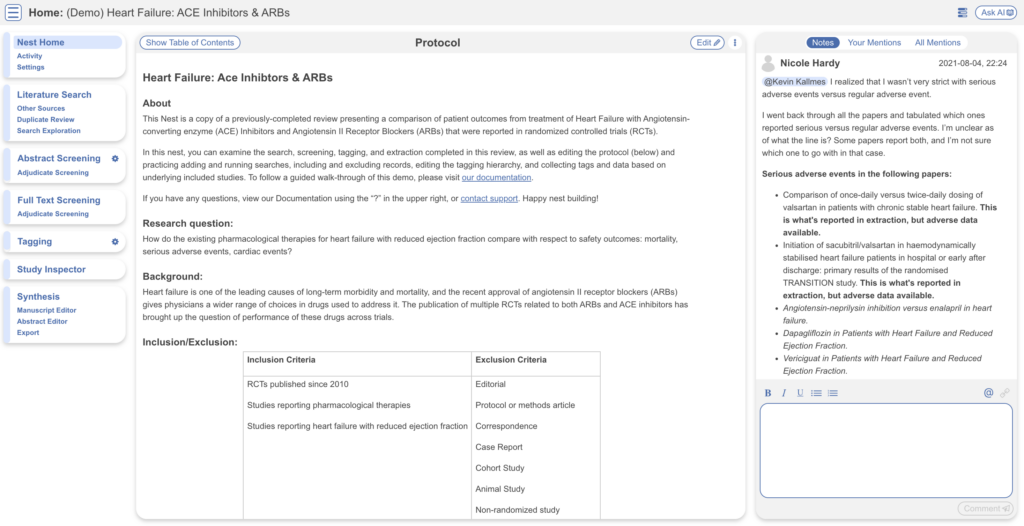
You’ve landed on your demo Nest in AutoLit, and you’re looking at the Nest Home page. This page includes a menu on the left of the page, the protocol in the center, and discussion about the Nest on the right. The menu includes links to all modules & configurations available to you in AutoLit. We’ll now walk through these modules one by one. (click the title in the menu to navigate to the the corresponding module).
Literature Search #
The Literature Search page allows import of studies to a nest and shows where studies were sourced. This demo nest intentionally has no searches in order to focus on demonstrating how to add records manually. So if you navigate to the “Literature Search” menu heading, it will show an empty table.
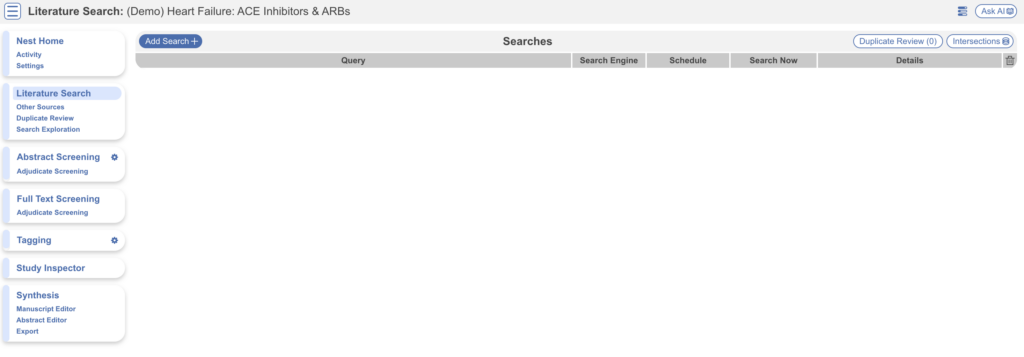
This is typically not standard practice for a review, and the original completed nest did include several searches. For the purposes of this demo, all 16 studies were manually imported into screening allowing you to follow the records all the way through the workflow.
Other Sources #
Records may be imported through other means. Click the “Other Sources” menu item under “Literature Search” to view records that were individually added as expert recommendations. 16 such studies were imported into this Nest. Try importing the DOI or PMID of your favorite study using the “Add by Identifier” form on the right of the page.
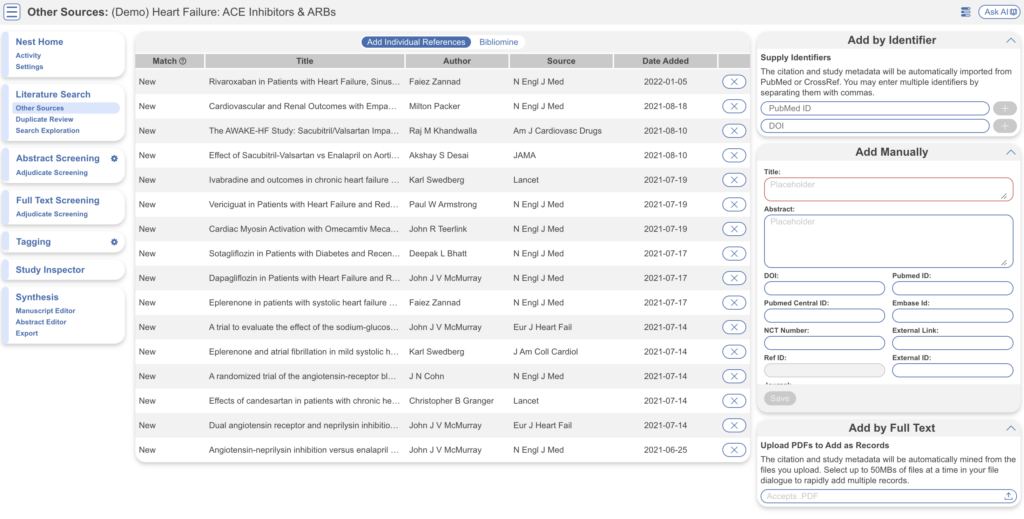
Search Exploration #
Navigate to Search Exploration see how a search query can be built and how the literature can be explored. Add concepts in the concept box, add them to groups and view the preview on the right (red). Select Refresh Exploration to explore a representation of Abstracts, PICOs, Study Types, Locations, Size, Topics, Acronyms, and Keywords.

Screening #
Once studies are imported into a nest, they are “Screened” for relevance to the review in the Screening Module. Click the Screening menu header to visit this module.
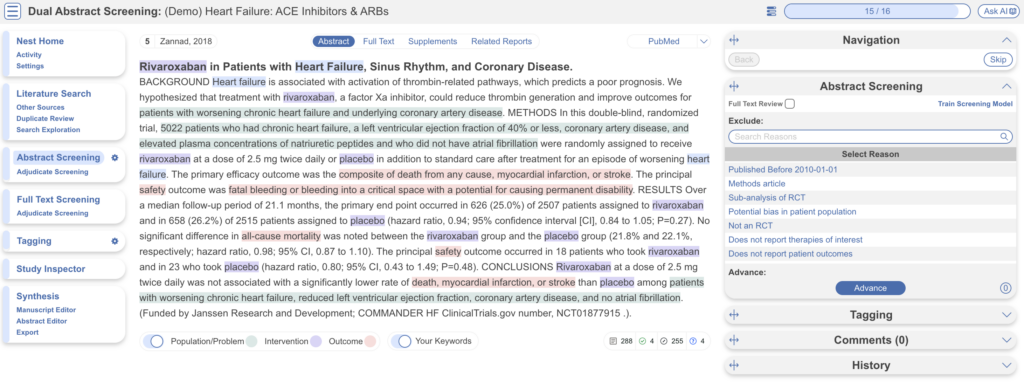
This screening module displays studies that have yet to be screened, allowing you to decide to advance/include or exclude from the rest of your review and analysis. You may exclude references by selecting an exclusion reason from the drop-down menu and then clicking the exclude button. You may also skip studies you aren’t yet sure about, or jump to a prior study, using the buttons under the Navigation menu.
Abstract Highlighting #
Why are study abstracts so colorful? We peform ML-based PICO annotation of abstracts using a model derived from RobotReviewer. To turn off PICO highlighting, toggle off the slide button in the legend just beneath the abstract text.
Abstract text may also be underlined with User Keywords, which are configured under the Settings menu item.
Tagging #
The Tagging module allows you to report data from included studies in the form of “tags”. There are two modes for Tagging, Standard or Form-based. This nest is configured for Standard Tagging.
Tag Hierarchy #
To configure the tag hierarchy, select the gear icon next to the Tagging menu item. Tag hierarchies consist of tags (visualized as points) and relationships between them (visualized as connecting lines). The tag hierarchy in this review consists of Interventions/Comparators (in purple on the left), Relevant Evidence, Analyses, and Critical Appraisals – these tags at the highest level are called “root” tags, everything below them are “child” tags.
Hierarchies should be created and read as a series of “is a” relationships. For example, “Adverse Event” is a “Outcome”, “Septic Shock” is a “Adverse Event”. Hover around the hierarchy to explore tags and read off the “is a” relationships as you go. Tags with a Q are configured as questions, click on these to explore question types.

Tagging Module #
Inside the Tagging module, tags may be applied to studies, indicating that a concept is relevant to a study.

In the Tagging form, select any tag from the dropdown menu, then click Apply Tag; it should now appear in the Tagging Table.
Click a row in the Tagging table that has a non-empty excerpt column to view past applied tags and their “excerpts”, which user-entered pieces of text, typically extracted from the manuscript, supporting the tag.
Study Inspector #
Study Inspector is the tool in AutoLit for reviewing and searching your past extracted data. Each row in Study Inspector is a study, and columns may be user-selected in the upper left dropdown menu. Studies may be searched into the table by creating Filters. Filters may be created using the Add Filter dropdown menu, but oftentimes the typeahead search bar is fastest. In the below example, we are filtering to studies with a full text uploaded and using the typeahead menu to find all included studies. Try out the title/abstract (TIAB) filter by typing “diabetes” into the search bar.
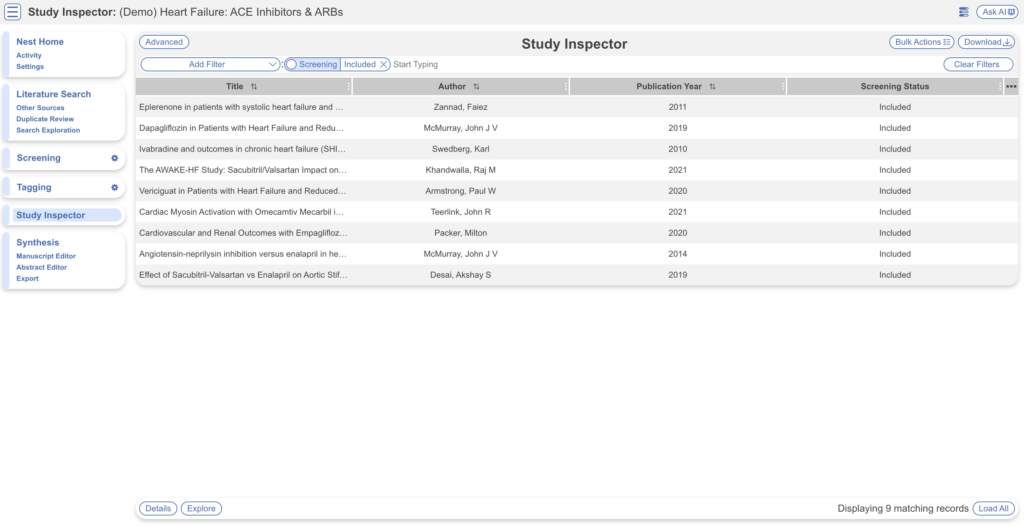
Meta-Analytical Extraction #
Please see our MA Extraction Documentation page to review how interventions and data elements were configured for this Nest. By default, MA Extraction and its output Quantitative Synthesis are off. To turn them on head to Settings:


Then Navigate to MA Extraction:

The Study Design form specifies intervention arms in the study (Placebo and Omecamtiv Mecarbil, in this case) as well as outcome measurement timepoints in the study.
The Extracted Data form contains means, medians, dichotomous rates, and categorical counts corresponding to baseline characteristics and outcomes for the study. Modify some of the data points, which will be auto-saved. If you enter incomplete or invalid data (e.g. a negative value for N), the leading Status column of the table will show a red X. Hover to view the error message.
Synthesis #
At this point, we’ve reviewed all the evidence gathered in AutoLit for the Heart Failure: ACE Inhibitors & ARBs Nest. Now let’s navigate to Synthesis Home to draw some conclusions from our evidence, by clicking the Synthesis menu heading.
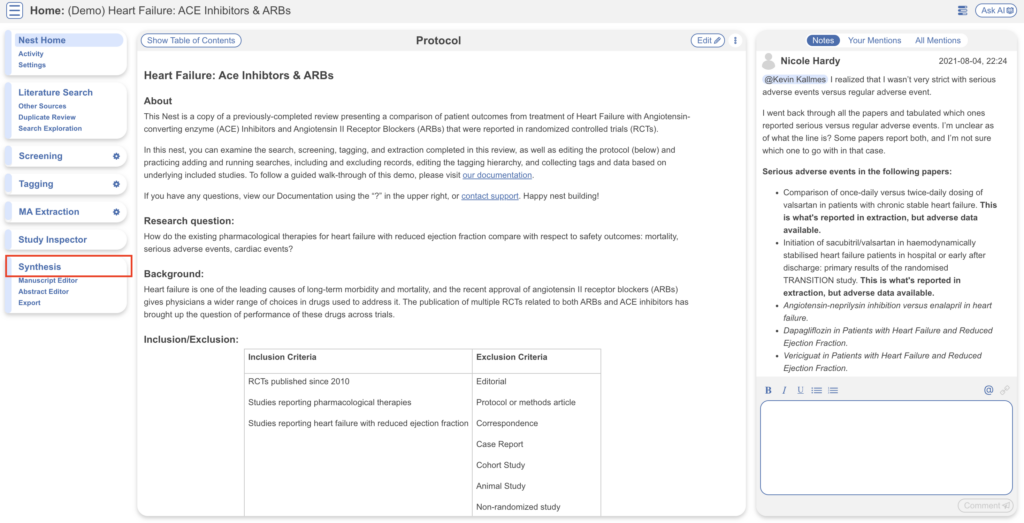
PRISMA #
Click the PRISMA button in the bottom left of the page to view a PRISMA 2020 flow diagram. The diagram is auto-populated based on searches imported and studies screened in AutoLit.

In this case, PRISMA is not particularly relevant to the type of searching performed, as only our 16 expert recommendations were considered for screening. Regardless, the diagram may be right clicked and saved as an arbtirary resolution SVG or exported in a variety of formats.
Qualitative Synthesis #
Navigate back to Synthesis Home and click the Qualitative Synthesis box. Qualitative Synthesis (QLS) displays data gathered in the Tagging Module. Each slice in the sunburst diagram is a tag. Its width corresponds to how frequently it was applied. Its distance from the center corresponds to its depth in the hierarchy (how many “is a” relationships are between it and its root tag). Click a slice to filter studies displayed to those where the tag was applied. Clicking multiple slices filters to studies with all the selected tags applied. The rightmost bar shows relevant studies (bottom) and some data about the tag (top), like its frequency, excerpts, and tags that were commonly applied with the selected tag.

In this tag selection, we see that Hyperkalaemia was reported as an outcome in 4 studies that included a patient population that was on an Ace Inhibitor at Baseline. Click the rows of the study table to take a deep dive into the extracted data.
Quantitative Synthesis #
Navigate back to Synthesis Home and click the Quantitative Synthesis box. Quantitative Synthesis (QNS) displays data gathered in the Extraction Module. QNS contains 3 different analyses automatically computed from extracted data.
The Summary tab contains pooled estimates of outcomes, broken out by interventions. Interventions may be expanded to different levels of precision, while outcomes analyzed may be selected from the dropdown menus. In the below example, we find a 17.6% mortality rate for Placebo against generally lower rates for other medications; Omecamtiv m ecarbil carries a 25.9% mortality rate, but the estimate is only built on a single, albeit large, study.

The NMA tab computes a Network Meta-Analysis, which estimates effect sizes between pairwise comparisons of interventions on an outcome. The NMA comes with a network diagram (showing how commonly interventions were compared with one another), an effect size matrix, and forest plots (accessed by clicking on a cell in the effects matrix). Use the intervention expansion menu on the right of the page to refine interventions analyzed.

Closing Remarks #
You’ve now seen how a review may be completed & shared with the Nested Knowledge platform. We encourage you to head back to AutoLit and explore the variety of configuration options, and ever-growing feature set we didn’t get to cover here. If you’re feeling ambitious, start your own Nest from scratch!
Use this documentation to guide you through more complex topics, and as always, please reach out to our support team via email and make requests on Nolt.

